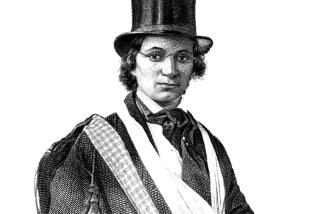English Roots
- Share via
“The Origins of American Slavery,” an essay on the origins of slavery in colonial North America, is sadly of contemporary as well as historical interest. There are still millions of bonded laborers in the world, while racial exclusion lives on in other forms. Betty Wood gives an account of historians’ debates concerning such questions as whether racial feeling produced slavery or whether slavery produced racism. She also briefly examines the economic motives in the construction of the slave system. Since these topics have been rattled around for several decades by knowledgeable and skilled historians, Wood’s discussion is not highly original, but she does furnish a useful summary, leaning a little toward the culturalist side of the controversies.
Wood reminds us of the way that the English of the 16th and 17th centuries entertained many derogatory stereotypes concerning blacks and Africans. Of course, such a famous text as “Othello” might be seen as evidence that Moors could possess manly and noble qualities, as well as display human frailty, but debate still continues today whether Shakespeare’s play did more to confirm than undermine the negative stereotypes. Wood points out that early modern English saw black as the color of sin and the devil, but she overlooks the fact that black was also the color of clerical garb and a marker of power in Baroque painting. Wood’s reading of these issues, however, is mainly right. English culture “denigrated” Africans and tended to deny them the protections afforded to Christian Europeans. Wood concludes, sensibly, that not only did racial feeling make black slavery more acceptable to English traders and colonists but also that the construction of the slave systems made matters worse, spawning an ideology of racial oppression.
Racial antipathy is, by itself, not a conclusive explanation. While the mass of colonists did nourish such antipathies, this did not mean that they wanted to introduce large numbers of captive Africans; indeed, in some cases, it led to demands for the exclusion of blacks.
But matters were different for the small minority that could afford to buy slaves. This is where economic motives came in. Once the slave labor force was already assembled, the planters could foster a noxious compound of racial fear and privilege. They could also project onto the slaves social images that in England were affixed to the Irish, to the shiftless poor and masterless men and women. In this way, early modern racism amalgamated and color-coded prejudices that had been directed against a variety of “undesirables.”
Wood’s inclination to give more space to the cultural settings than to economic forces is in line with much modern writing and certainly does not lead her to deny the greed of the planters and traders. What she misses, however, is a wider issue than motivation. She neglects the arguments put forth in the classic study “Capitalism and Slavery” by Trinidadian historian Eric Williams. In fact, the market for plantation produce was indeed the result of a new pattern of society, in which traders were less constrained by a traditional morality and in which consumers were at a great psychological, as well as physical, distance from the source of their new pleasures. Because heedless consumerism is still very much with us--we often know little about the human and ecological costs of what we buy--its contribution to the spread of slavery could have been given more attention.
But by skimping a little on new modes of consumption and their link to the cash nexus, Wood explores other less familiar aspects of the problem of slavery’s growth in America by comparing the different types of English colony. While acknowledging the prior practice of slavery by the Spanish and Portuguese colonists, she largely confines her attention to the English colonies. She devotes nearly as much space to the condition of free and enslaved Africans in New England, New York and Pennsylvania as to the plantation colonies where slavery flourished.
Of course, even the Northern colonies were not insulated from the economic pressures of plantation slavery because some of their own prosperity rested on exchanges with the Caribbean and with Virginia. But Wood’s account of black bondage in the North highlights the oppression of Africans even in contexts in which they were not quite full chattel slaves.
Wood also explores the bearing of religion on the legitimation of slavery. It is difficult to overestimate the influence of religious world views in the early modern epoch. Thus, even standard bearers of science like Isaac Newton remained attached to a biblically rooted view of history. Englishmen in the 17th century believed that all the peoples of the world descended from Noah’s three sons. One consequence of this was the belief that heathen peoples were not simply ignorant of religious truth but that they had actively renounced Noah’s teachings and the knowledge of God. The strange languages they spoke were a sign, like their other strange customs, that they had rejected the language of the Scriptures and of civilized communication. Such notions made it easier for Native Americans or West Africans to be seen as potentially enslaveable savages. And their heathenism was aggravated if they persisted in their strange customs even after being shown the error of their ways.
As it turned out, the communities of Native Americans were far better placed to escape or resist enslavement, albeit at great cost; their mode of life made them less adaptable to plantation labor anyway.
As Wood shows, prevailing religious doctrines tended to identify West Africans as more worthy of enslavement. Not only were they heathens, but Noah had supposedly cursed his son Ham for an offense against his patriarchal dignity, condemning his posterity to servitude. While the original redactors of Genesis had no notion of Africa, early modern English readers of the Bible did; when they read that Ham’s sons lived in Egypt, Libya and Ethiopia, they often concluded that black Africans were most probably sons of Ham. They also found in Leviticus precepts permitting the holding of strangers in bondage.
Wood shows that a complex of such attitudes prejudiced the position of African servants in the Puritan colonies, as well as in Barbados and Virginia. Northern blacks were offered some legal protection and “Christian usage,” but they were nowhere the civic equals of whites: The majority, indeed, were reduced to a species of permanent servitude. Among the few voices raised against this degradation were religious dissidents such as Morgan Godwyn and George Fox, the Quaker leader--both pioneers of a more humane and universalist Christianity. Unfortunately, these men were not listened to, even by their coreligionists.
At moments of great social and political turmoil--1649 in England or 1676 in Virginia--there were hints that the common people did not wholeheartedly embrace colonialism and slavery and saw those systems as means to enrich leading men who were already too powerful. But so long as those men were in control, winning the wars they chose to fight and not falling out among themselves, neither religious nor political dissidents were going to gain a hearing.
Wood does not have a great deal to say about the Africans themselves; compared with later periods, there is a dearth of literary or material documentation on African responses to their captivity. In the Caribbean, there are unmistakable signs of the birth of a Creole culture as well as evidence of the beginnings of resistance by communities of African maroons (runaway slaves). In North America, where slaves were still a small minority in 1700, the response was more likely to be individual or small in scale. Wood also tells the reader little about the key players in London who ratified the new slave laws and battened on plantation profits. But as a study of its chosen subject, “The Origins of American Slavery” is compact, informative and thoughtful.
More to Read
The biggest entertainment stories
Get our big stories about Hollywood, film, television, music, arts, culture and more right in your inbox as soon as they publish.
You may occasionally receive promotional content from the Los Angeles Times.










